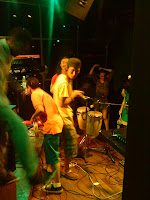From the moment I first arrived in Japan my impressions have been constantly changing, and will always continue to do so.
However, I still find it difficult to analyse without comparing. I’ve heard that my home country (UK), like Japan, is known for politeness, and is sometimes referred to as having a ‘gentleman’ culture (dead and gone generations ago); yet our ‘politeness’ and Japanese ‘politeness’ are entirely different. The sign below confused me completely, and also serves as an example of differentiating political correctness, along with a lot of other issues, but from my experience it was a 'one-off'...
If I was to attempt to describe what I believe to be the biggest difference, it would be that the Japanese approach is more decorated and ritual. The immediate examples are the heightened importance of gift giving, the way visitors are treated (when coming to a person’s house) and of course the bowing. I feel that in Japanese culture, this is only a single among many (maybe even all) aspects of Japanese life that are endowed with a strong sense of ritual.
A module at my home university last year required us to read the book Evanescence and Form by Charles Shiro Inouye. This book sought to explain the balancing act that ritual and change play in Japanese culture. It used examples from the Heian period right up to Miyazaki to explain the equal relationship between evanescence and form. I feel it also applies to the way experiences develop....
Since arriving here I’ve been looking for this theme in every aspect of life. My feelings about it are quite mixed, although at present I think I may have encountered more form than evanescence.
This is in no way a criticism, but in my opinion the Japanese approach to religion places the ceremony above obedience to the original content, and isn’t afraid to ‘cherry pick’ between religions to find a ritual appropriate to the occasion. I’ve also found this can apply to personal relationships….
Whenever I go on a trip to another area, it’s become second nature to buy a souvenir for the home-stay family. Previously I always skipped the gift shops; my natural opinion was that they detract from the travelling itself (especially to natural places) but it seems socially mandatory in Japan to find a balance between the two.
It could even apply to taking off shoes before entering and using separate slippers for the bathroom – physical space divided by ritual.
These are just among many impressions that are continually changing. The recently watched documentaries, particularly “The Cove”, “The great happiness space” and “Against coercion” have also greatly influenced my ongoing considerations.
Unfortunately I don’t have a definitive conclusion or realization to write about. Personally I think it’s a bad idea to have a single impression for too long; so this as the title suggests, this blog post covers only ‘changing impressions’ and not ‘changed impressions’. Maintaining this approach and keeping an open mind applies to learning about any culture; but for now, in terms of Japan, my first rosy impressions have grown up through more intimate experiences, certainly including some negative ones; but the experience so far have been overwhelmingly positive and has further fueled the ever existing curiosity to learn more about this country and its inhabitants.



























